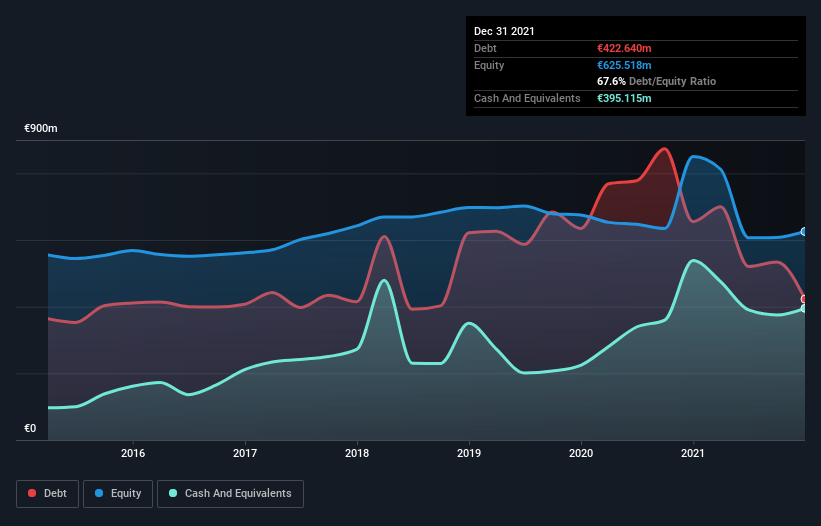Some say volatility, rather than debt, is the best way to think about risk as an investor, but Warren Buffett famously said that 'Volatility is far from synonymous with risk.' So it might be obvious that you need to consider debt, when you think about how risky any given stock is, because too much debt can sink a company. Importantly, ENCE Energía y Celulosa, S.A. (BME:ENC) does carry debt. But is this debt a concern to shareholders?
When Is Debt A Problem?
Debt assists a business until the business has trouble paying it off, either with new capital or with free cash flow. If things get really bad, the lenders can take control of the business. However, a more common (but still painful) scenario is that it has to raise new equity capital at a low price, thus permanently diluting shareholders. Of course, the upside of debt is that it often represents cheap capital, especially when it replaces dilution in a company with the ability to reinvest at high rates of return. The first step when considering a company's debt levels is to consider its cash and debt together.
See our latest analysis for ENCE Energía y Celulosa
What Is ENCE Energía y Celulosa's Net Debt?
As you can see below, ENCE Energía y Celulosa had €422.6m of debt at December 2021, down from €654.8m a year prior. However, it does have €395.1m in cash offsetting this, leading to net debt of about €27.5m.

How Healthy Is ENCE Energía y Celulosa's Balance Sheet?
Zooming in on the latest balance sheet data, we can see that ENCE Energía y Celulosa had liabilities of €353.2m due within 12 months and liabilities of €634.2m due beyond that. Offsetting this, it had €395.1m in cash and €96.7m in receivables that were due within 12 months. So its liabilities total €495.6m more than the combination of its cash and short-term receivables.
This deficit is considerable relative to its market capitalization of €732.4m, so it does suggest shareholders should keep an eye on ENCE Energía y Celulosa's use of debt. This suggests shareholders would be heavily diluted if the company needed to shore up its balance sheet in a hurry.
We measure a company's debt load relative to its earnings power by looking at its net debt divided by its earnings before interest, tax, depreciation, and amortization (EBITDA) and by calculating how easily its earnings before interest and tax (EBIT) cover its interest expense (interest cover). Thus we consider debt relative to earnings both with and without depreciation and amortization expenses.
ENCE Energía y Celulosa has a very low debt to EBITDA ratio of 0.25 so it is strange to see weak interest coverage, with last year's EBIT being only 0.63 times the interest expense. So while we're not necessarily alarmed we think that its debt is far from trivial. We also note that ENCE Energía y Celulosa improved its EBIT from a last year's loss to a positive €18m. There's no doubt that we learn most about debt from the balance sheet. But it is future earnings, more than anything, that will determine ENCE Energía y Celulosa's ability to maintain a healthy balance sheet going forward. So if you're focused on the future you can check out this free report showing analyst profit forecasts.
Finally, a company can only pay off debt with cold hard cash, not accounting profits. So it's worth checking how much of the earnings before interest and tax (EBIT) is backed by free cash flow. Over the last year, ENCE Energía y Celulosa actually produced more free cash flow than EBIT. That sort of strong cash conversion gets us as excited as the crowd when the beat drops at a Daft Punk concert.
Our View
Based on what we've seen ENCE Energía y Celulosa is not finding it easy, given its interest cover, but the other factors we considered give us cause to be optimistic. In particular, we are dazzled with its conversion of EBIT to free cash flow. Looking at all this data makes us feel a little cautious about ENCE Energía y Celulosa's debt levels. While debt does have its upside in higher potential returns, we think shareholders should definitely consider how debt levels might make the stock more risky. When analysing debt levels, the balance sheet is the obvious place to start. However, not all investment risk resides within the balance sheet - far from it. We've identified 1 warning sign with ENCE Energía y Celulosa , and understanding them should be part of your investment process.
If, after all that, you're more interested in a fast growing company with a rock-solid balance sheet, then check out our list of net cash growth stocks without delay.
Valuation is complex, but we're here to simplify it.
Discover if ENCE Energía y Celulosa might be undervalued or overvalued with our detailed analysis, featuring fair value estimates, potential risks, dividends, insider trades, and its financial condition.
Access Free AnalysisHave feedback on this article? Concerned about the content? Get in touch with us directly. Alternatively, email editorial-team (at) simplywallst.com.
This article by Simply Wall St is general in nature. We provide commentary based on historical data and analyst forecasts only using an unbiased methodology and our articles are not intended to be financial advice. It does not constitute a recommendation to buy or sell any stock, and does not take account of your objectives, or your financial situation. We aim to bring you long-term focused analysis driven by fundamental data. Note that our analysis may not factor in the latest price-sensitive company announcements or qualitative material. Simply Wall St has no position in any stocks mentioned.
About BME:ENC
ENCE Energía y Celulosa
Produces and sells hardwood pulp and renewable energy in Spain, Germany, Poland, Italy, the Netherlands, the United Kingdom, Greece, France, Turkey, and internationally.
Fair value with moderate growth potential.
Similar Companies
Market Insights
Community Narratives



